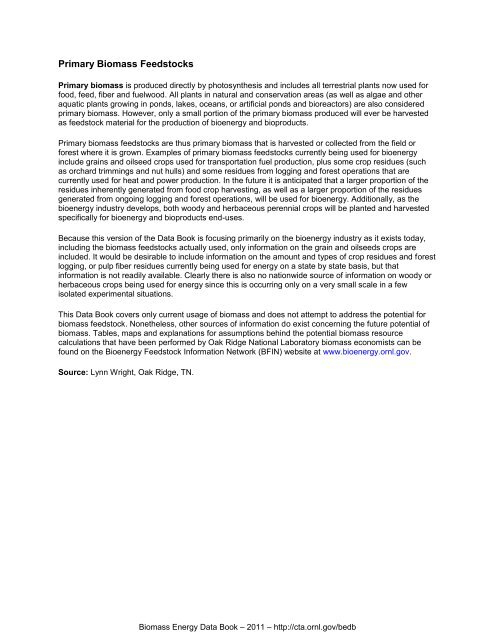Biomass Energy Data Book: Edition 4 - Full Document - Center for ...
Biomass Energy Data Book: Edition 4 - Full Document - Center for ...
Biomass Energy Data Book: Edition 4 - Full Document - Center for ...
Create successful ePaper yourself
Turn your PDF publications into a flip-book with our unique Google optimized e-Paper software.
Primary <strong>Biomass</strong> Feedstocks<br />
Primary biomass is produced directly by photosynthesis and includes all terrestrial plants now used <strong>for</strong><br />
food, feed, fiber and fuelwood. All plants in natural and conservation areas (as well as algae and other<br />
aquatic plants growing in ponds, lakes, oceans, or artificial ponds and bioreactors) are also considered<br />
primary biomass. However, only a small portion of the primary biomass produced will ever be harvested<br />
as feedstock material <strong>for</strong> the production of bioenergy and bioproducts.<br />
Primary biomass feedstocks are thus primary biomass that is harvested or collected from the field or<br />
<strong>for</strong>est where it is grown. Examples of primary biomass feedstocks currently being used <strong>for</strong> bioenergy<br />
include grains and oilseed crops used <strong>for</strong> transportation fuel production, plus some crop residues (such<br />
as orchard trimmings and nut hulls) and some residues from logging and <strong>for</strong>est operations that are<br />
currently used <strong>for</strong> heat and power production. In the future it is anticipated that a larger proportion of the<br />
residues inherently generated from food crop harvesting, as well as a larger proportion of the residues<br />
generated from ongoing logging and <strong>for</strong>est operations, will be used <strong>for</strong> bioenergy. Additionally, as the<br />
bioenergy industry develops, both woody and herbaceous perennial crops will be planted and harvested<br />
specifically <strong>for</strong> bioenergy and bioproducts end-uses.<br />
Because this version of the <strong>Data</strong> <strong>Book</strong> is focusing primarily on the bioenergy industry as it exists today,<br />
including the biomass feedstocks actually used, only in<strong>for</strong>mation on the grain and oilseeds crops are<br />
included. It would be desirable to include in<strong>for</strong>mation on the amount and types of crop residues and <strong>for</strong>est<br />
logging, or pulp fiber residues currently being used <strong>for</strong> energy on a state by state basis, but that<br />
in<strong>for</strong>mation is not readily available. Clearly there is also no nationwide source of in<strong>for</strong>mation on woody or<br />
herbaceous crops being used <strong>for</strong> energy since this is occurring only on a very small scale in a few<br />
isolated experimental situations.<br />
This <strong>Data</strong> <strong>Book</strong> covers only current usage of biomass and does not attempt to address the potential <strong>for</strong><br />
biomass feedstock. Nonetheless, other sources of in<strong>for</strong>mation do exist concerning the future potential of<br />
biomass. Tables, maps and explanations <strong>for</strong> assumptions behind the potential biomass resource<br />
calculations that have been per<strong>for</strong>med by Oak Ridge National Laboratory biomass economists can be<br />
found on the Bioenergy Feedstock In<strong>for</strong>mation Network (BFIN) website at www.bioenergy.ornl.gov.<br />
Source: Lynn Wright, Oak Ridge, TN.<br />
<strong>Biomass</strong> <strong>Energy</strong> <strong>Data</strong> <strong>Book</strong> – 2011 – http://cta.ornl.gov/bedb
















